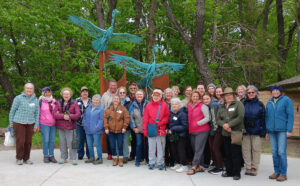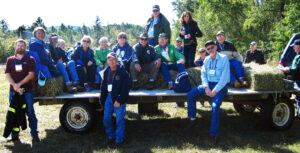By Art Kabelowsky, DNR Outreach and Communications, Fitchburg Arthur.Kabelowsky@wisconsin.gov; 608-335-0167

Nancy Bozek (far right), executive director of the Wisconsin Woodland Owners Association (WWOA), joins the Women of WWOA group for a photo after a guided tour of the International Crane Foundation outside of Baraboo. / Photo Credit: Contributed by Nancy Bozek
There are plenty of trees in Wisconsin forests that haven’t been around as long as the Wisconsin Woodland Owners Association (WWOA).
In many cases, the 46-year-old WWOA has facilitated the information sharing, networking and hard work necessary to keep as many of those trees as possible, along with the older ones, of course, green and growing.
WWOA’s mission statement is one of those simple ideas that needs a lot of effort to become reality: “(T)o conserve and enhance the private woodlands of the state through the following actions:
- Sustainably manage our woodlands with informed management plans that utilize best silviculture practices.
- Assist private landowners in achieving their management goals by connecting them with natural resource professionals and fellow woodland owners.
- Educate the public on the value of woodlands for economic, environmental, recreational and wildlife habitat purposes.”
The ideas, goals and performance of WWOA have proven to be a strong draw for woodland owners. The group’s executive director, Nancy Bozek, said WWOA is one of the largest private woodland owners’ associations in the United States, bringing together more than 1,500 members.

During the 2024 Wisconsin Woodland Owners Association annual meeting near Stevens Point, hosts Jim and Deb Swanson demonstrate their portable sawmill for visitors from the WWOA. / Photo Credit: Contributed by Nancy Bozek
WWOA’s stated vision is to be the go-to organization to assist woodland owners in achieving their sustainable forestry goals. Bozek said her group is open to woodland owners with varied backgrounds, knowledge levels and goals for their woodlands.
“Our missions align so well with the MFL [Managed Forest Law] program. … (and) people find that if they’re in the MFL, they’re more engaged with their forester and they learn things they might not have been aware of about their forests,” she added. “Our members want to learn more, and they all want to do a wonderful job of caring for their land. It’s something that brings us together.”
Bozek said “at least 50 percent of our members are part of the (MFL) program. It’s not uncommon to hear stories of WWOA member families with second and third generations managing their privately owned woodlands through the MFL program.
One example is the Thompson family, which owns woodlands in Buffalo, Clark, Portage and Trempealeau counties, all under MFL.
The family patriarch, Dick Thompson, said he bought a 40-acre farm in 1966. Noticing the land featured sandy soil, they planted red pine, white pine and spruce trees, not for financial reasons, but to preserve the land and support the neighboring forested county land.
After years and years of work, they formed an LLC to protect their growing estate, which now included properties in four counties. Their son, Steve, and granddaughter, Elizabeth, have stepped up to show interest in taking over as primary land managers for the next two generations.
They say everyone in the family enjoys spending time at “the tree farm,” working on the trees, hiking, crafting and doing other nature-focused activities.

Members of the Wisconsin Woodland Owners Association (WWOA) gather for a hayride back to their vehicles after a field day stop as part of the WWOA’s annual meeting. / Photo Credit: Contributed by Nancy Bozek
It’s all part of a connection that so many humans naturally are drawn to; with nature, with land, with trees. And WWOA exists to not only foster those connections, but to maximize the effectiveness of those connections for both the individuals and the woodlands.
“Members are willing to share their experiences, whether they’re good or whether they didn’t quite work out,” Bozek said. “And MFL is part of that, because you learn so much more. You get a written management plan, and that helps you get a clearer picture of what your woodland can become.”
Bozek said WWOA works to bridge the knowledge gap between natural resources professionals and woodland owners. “We help them learn the “alphabet soup” of programs that are available to assist them, from DNR and other organizations.”
WWOA uses many methods to build those bridges:
- An information-packed website serves as a welcome first stop for those seeking information.
- A quarterly magazine offers a vast and varied array of articles, tips and personality spotlights, and a weekly “Learn Something New” educational e-mail is distributed to all members.
- Regular meetings of WWOA’s regional chapters, Women of WWOA, and other events organized by WWOA for woodland owners. “You may have to travel across the state to get to the annual meeting,” Bozek said, “but the chapter events might be right in your backyard and have information that applies to your property.”
- And the highlight of the year; an annual four-day, all-membership meeting that typically draws 200 to 250 members each September.
The annual meeting includes a board meeting, two days of tours, a keynote and concurrent session speakers, an awards banquet in partnership with the Wisconsin Tree Farm Committee and a field day. The field day offers eight to 10 stations on a variety of topics and members can choose the ones of interest.
This year’s annual meeting will take place Sept. 18-21 in La Crosse. The keynote speaker will be Fred Clark of Wisconsin Green Fire, who will present a report on Wisconsin Forests at Risk.
WWOA has proven to be such a valuable source of interesting and practical information that, Bozek says “even people without woodlands may become members if they want to learn more about Wisconsin’s woodlands.” She said there are people who take them up on that offer.
WWOA welcomes people who reside in other states, as well. “Even though we have members who don’t live in Wisconsin, the majority of them either own Wisconsin woodlands or have a deep appreciation of Wisconsin woodlands,” Bozek said.
“It’s a very supportive type of organization, not competitive. We’re very family centered.”
Landowners interested in joining WWOA can check out the membership brochure.
